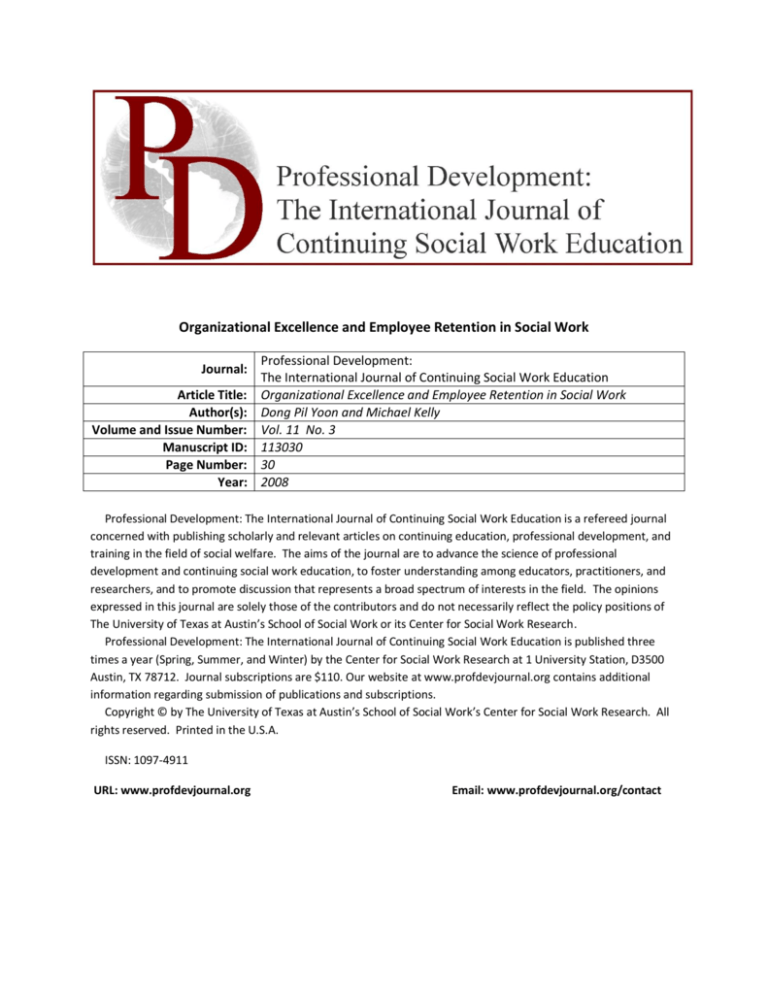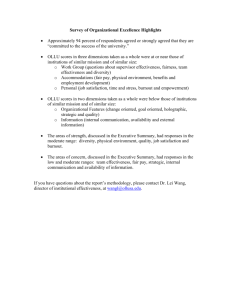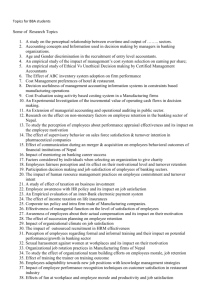
Organizational Excellence and Employee Retention in Social Work
Journal:
Article Title:
Author(s):
Volume and Issue Number:
Manuscript ID:
Page Number:
Year:
Professional Development:
The International Journal of Continuing Social Work Education
Organizational Excellence and Employee Retention in Social Work
Dong Pil Yoon and Michael Kelly
Vol. 11 No. 3
113030
30
2008
Professional Development: The International Journal of Continuing Social Work Education is a refereed journal
concerned with publishing scholarly and relevant articles on continuing education, professional development, and
training in the field of social welfare. The aims of the journal are to advance the science of professional
development and continuing social work education, to foster understanding among educators, practitioners, and
researchers, and to promote discussion that represents a broad spectrum of interests in the field. The opinions
expressed in this journal are solely those of the contributors and do not necessarily reflect the policy positions of
The University of Texas at Austin’s School of Social Work or its Center for Social Work Research.
Professional Development: The International Journal of Continuing Social Work Education is published three
times a year (Spring, Summer, and Winter) by the Center for Social Work Research at 1 University Station, D3500
Austin, TX 78712. Journal subscriptions are $110. Our website at www.profdevjournal.org contains additional
information regarding submission of publications and subscriptions.
Copyright © by The University of Texas at Austin’s School of Social Work’s Center for Social Work Research. All
rights reserved. Printed in the U.S.A.
ISSN: 1097-4911
URL: www.profdevjournal.org
Email: www.profdevjournal.org/contact
Organizational Excellence and Employee Retention in Social Work
Dong Pil Yoon, PhD and Michael J. Kelly, PhD
insight into how organizational leadership is involved in understanding and controlling turnover,
the authors turn to data from a standard organizational assessment and data recently gathered from
a moderately sized human service organization in
a Midwestern state. The tool used to assess organizational members’ attitudes on these variables is
the Survey of Organizational Excellence.
Introduction
Turnover is an important cost, performance, and
morale challenge for any organization. In every
case the organization should be considering factors
to increase employee retention. Other job opportunities, change in personal status, education, and
work satisfaction all contribute to the rate of turnover for an organization. In a moderate-sized organization, such as one with a few hundred employees, turnover of 5 to 10 percent can be positive
for the organization as new members often bring
other perspectives, higher energy levels and recently acquired education. However, any turnover
must be balanced against a number of factors. One
is the degree to which existing members can pick
up the slack when an experienced member is lost,
their availability to train and socialize the new
member, and the psychological impact of seeing
another leave the organization. When members
perceive high levels of turnover then these burdens
increase and both performance and morale may
suffer. In some organizations the cost of turnover
simply to recruit, select, and train the new employee will run more than $50,000 per employee.
To the extent that the position requires several
months before the new employee comes up to
speed then an additional cost is incurred as existing
employees must undertake reparative efforts, while
a lessened job load is created for the new employee
to learn the tasks.
New employees pull down heavily on supervisory and training staff. High rates of turnover deter
service improvement and absorb resources that
might be applied to task improvement.
To understand and control the level of turnover
it is important to have a working theory of variables that may account for turnover. One might
suspect that pay, working conditions, education,
gender, job satisfaction, and general organizational
morale might all contribute. To see if these variables do account for turnover and to provide some
Instrumentation
The Survey of Organizational Excellence
The Survey of Organizational Excellence has
been developed and tested extensively in public
and private organizations in Texas and other
states. It is designed to assess the climate in organizations, particularly service organizations,
and so is broad in scope and language. This instrument is particularly well-suited to the present
study as it was developed to promote an environment of self-reflection and learning in organizations (Lauderdale, 2001b) and it is quite broad. It
measures five workplace dimensions (work
group, work setting, organizational features, communication, and personal demands), within which
have been identified twenty constructs, including
supervisory effectiveness, team effectiveness,
organizational change-oriented, goal oriented, and
quality. (Lauderdale, 1999). The instrument also
captures sixteen demographic or descriptive variables, including job category, highest educational
level, salary level, and years of service with the
organization (Lauderdale, 2001a).
The instrument’s development and improvement over the past thirty years included initial
identification of concepts to be measured through
review of organizational literature, focus groups
with public agency employees, pretesting of the
instrument, and original piloting in 1979 with
3,000 persons and then with 62,000 public employees in 1994. The instrument has demonstrated through repeated testing to be reliable
Dong Pil Yoon, PhD is an Associate Professor at the University of Missouri-Columbia.
Micheal J. Kelly, PhD is a Professor at the University of Missouri-Columbia.
30
Organizational Excellence and Employee Retention
(Cronbach’s alpha of .85 or greater). Particular
subscales have been subject to establishment of
convergent validity with other instruments, such as
the burnout subscale with Dean’s Alienation Scale,
and Maslach’s Burnout Inventory, and have been
found to be sound measures. This instrument has
been designed primarily as a repeated measure
instrument for use in measuring organizational
culture over time. Therefore particular attention
has been paid to face validity through expert review by agency employees and administrators in
many organizations. In addition, content validity
has been established through comparison of data to
ratings by trained observers Lauderdale, 1999).
The most recent review by an expert panel of users
was in 2000 (M. J. Kelly, personal communication,
May 11, 2004).
from the viewpoint of employees of the competitiveness of the total compensation package, addressing how well the package holds up when
employees compare it to similar jobs in their own
communities. Adequacy of physical environment
captures employees’ perceptions of the work setting and the degree to which employees believe
that a safe and pleasant work environment exists.
Benefits provide an indication of the role that the
employment benefit package plays in attracting
and retaining employees. Employee development
captures perceptions of the priority given to the
career and personal development of employees by
the organization. Each sub scale consisted of a 5point response format, ranging from 1(strongly
disagree) to 5 (strongly agree). Cronbach’s alpha
was .81 for this sample. Higher scores reflect
better accommodations.
Variables and Instruments
Work group
“Work group” has four sub scales including
supervisor effectiveness, fairness, team effectiveness, and diversity. Supervisor effectiveness provides insight into the nature of supervisory relationships in the organization, including the quality
of communication, leadership, and fairness that
employees perceive exists between supervisors and
themselves. Fairness measures the extent to which
employees believe that equal and fair opportunity
exists for all members of the organization. Team
effectiveness captures employees’ perceptions of
the effectiveness of their work group and the extent to which the organizational environment supports appropriate teamwork among employees.
Diversity addresses the extent to which employees
feel that individual differences, including ethnicity,
age, and lifestyle, may result in alienation and/or
missed opportunities for learning or advancement.
Each sub scale consisted of a 5-point response format, which ranged from 1 (strongly disagree) to 5
(strongly agree). Cronbach’s alpha was .72 in this
sample. A higher score indicates a better work
group.
Organizational features
There are five sub scales of organizational
features: change oriented, goal oriented, holographic, strategic, and quality. Change oriented
secures employees’ perceptions of the organization’s capability and readiness to change based on
new information and ideas. Goal oriented addresses the organization’s ability to include all its
members in focusing resources towards goal accomplishment. Holographic refers to the degree
to which all actions of the organization hang together and are understood by all, particularly concerning employees’ perceptions of the consistency of decision-making and activity within the
organization. Strategic orientation secures employees’ thinking about how the organization
responds to external influence, including those
which play a role in defining the mission, services, and products provided by the organization.
Quality focuses upon the degree to which quality
principles, such as customer service and continuous improvement, are a part of the organizational
culture. Each sub scale consisted of a 5-point
response format, which ranged from 1 (strongly
disagree) to 5 (strongly agree). Cronbach’s alpha
was .75 in this sample. Higher scores reflect better organizational features.
Accommodations
There are four sub scales to accommodations:
fair play, physical environment, benefits, and employee development. Fair play is an evaluation
31
Organizational Excellence and Employee Retention
powerment. Overall, two hierarchical regression
models were used to determine each level of dependent variables. In Model 1, the independent
variable included the demographic variables of
age, ethnicity (dichotomously coded as 1 = White
and 0 = Non-White), education (dichotomously
coded as 1 = bachelor’s degree or above, 0 = no
bachelor’s degree), annual income
(dichotomously coded as 1 = > $25,000, 0 = ≤
$25,000), number in household (dichotomously
coded as 1 = single, 0 = family), and years in service (dichotomously coded as 1 = > 5 years, 0 = ≤
5 years). The Model 2 included work, accommodations, organization, and information. In addition, the logistic regression method was used to
predict perception of turnover.
Information
Information is composed of three sub scales
including internal communication, availability of
information, and external communication. Internal
communication captures the nature of communication exchanges within the organization, addressing
the extent to which employees view information
exchanges as open and productive. Availability of
information provides insight into whether employees know where to get needed information and
whether they have the ability to access it in a
timely manner. External communication looks at
how information flows in and out of the organization, focusing on the ability of the organization to
synthesize and apply external information to work
performed by the organization. Each sub scale
consisted of a 5-point response format, ranging
from 1(strongly disagree) to 5 (strongly agree).
Cronbach’s alpha was .75 for this sample. Higher
scores reflect better information.
Characteristics of the Participants
Overall, females comprised approximately 88
percent of the participants, while males comprised approximately 12 percent of the participants. Most participants (87%) were White and
82 percent had bachelor’s degree. Annual income
categories included 127 individuals reporting
under $25,001 (17%), 606 reporting between
$25,001- $35,000 (81%), and 18 individuals reporting over $35,000 (2%). In terms of years in
service, 39% had worked at least six years. Sixty
-seven percent of the respondents planned to still
be working for the organization in two years,
though most respondents (89%) were not promoted during the last two years.
Personal
Job satisfaction addresses employees’ satisfaction with their overall work situation, concerning
their evaluation of the availability of time and resources needed to perform jobs effectively. Time
and stress management looks at how realistic job
demands are, given the constraints of time and
resources, and also captures the feelings employees
have about their ability to balance home and work
demands. Burnout is a feeling of extreme mental
exhaustion that can negatively impact employees’
physical health and job performance, leading to
lost resources and opportunities in the organization. Empowerment measures the degree to which
employees feel that they have some control over
their jobs and the outcome of their efforts. Each
sub scale consisted of a 5-point response format,
which ranged from 1 (strongly disagree) to 5
(strongly agree). Cronbach’s alpha was .85 in this
sample. Higher scores reflect better personal attitudes.
Multivariate Analyses
Job Satisfaction. Table 2 indicates that Model
2 accounts for 56% of the variance in job satisfaction (F = 93.93, p < .001; adjusted R2 = .56). In
Model 1, among participant’s demographic information, annual income significantly predicted job
satisfaction. In Model 2, as expected, work, accommodations, and organization were significant
predictors of a subject’s job satisfaction, explaining an additional 52% (p < .001) of the variance
in job satisfaction. Thus, having better work,
accommodations, and organization predicts
higher job satisfaction.
Time and Stress. Table 2 indicates that Model
2 accounts for 53% of the variance in time and
Data Analyses
Hierarchical multiple regression analyses were
performed to determine the relative influence of
four sets of variables on the dependent variables:
job satisfaction, time and stress, burnout, and em32
Organizational Excellence and Employee Retention
stress (F = 93.93, p < .001; adjusted R2 = .52). In
Model 1, annual income was a significant predictor
of time and stress. In Model 2, as expected, in the
equation to predict time and stress, accommodations, organization, and information appeared to
contribute significantly and explained an additional
48% (p < .001) of the variance in time and stress.
Thus, having better accommodations, organization,
and information predicts better time and stress
management.
Burnout. Table 2 indicates that Model 2 accounts for 73% of the variance in burnout (F =
93.93, p < .001; adjusted R2 = .72). In Model 1,
among demographic information, annual income,
number in the household, and years in service
significantly predicted burnout. In Model 2, as
expected, work, accommodations, organization,
and information were significant predictors of a
subject’s burnout, explaining an additional 67%
(p < .001) of the variance in burnout. Thus, hav33
Organizational Excellence and Employee Retention
34
Organizational Excellence and Employee Retention
ment.” Austin, TX, University of Texas Press.
Lauderdale, M. a. K., Michael (2003). "Meeting Transformational Challenges: Continuing education and
leadership." Professional Development: The International Journal of Continuing Social Work Education Fall.
ing better work, accommodations, organization,
and information predicts lower levels of burnout.
Empowerment. Table 2 indicates that Model 2
accounts for 81% of the variance in empowerment
(F = 93.93, p < .001; adjusted R2 = .81). In Model
1, among demographic information, annual income, number in the household, and years in service significantly predicted empowerment. In
Model 2, as expected, in the equation to predict
empowerment, work, accommodations, and organization appeared to contribute significantly and
explained an additional 74% (p < .001) of the variance in empowerment. Thus, having better work,
accommodations, organization, and information
predicts greater empowerment.
Discussion
Our findings contain very few surprises. Some
conditions -- such as low wages, poor facilities,
and skimpy benefits -- will make people dissatisfied and prone to leave. These are the hygiene conditions. Other conditions -- such as challenging
work, recognition, ability to pursue quality -- are
factors that speak to the quality of leadership and
opportunity to participate in the organization. They
motivate people to work and to stay at the organization. When both conditions are met people stay,
work hard, and build strong organizations.
Conclusion
Organizations can utilize survey methods to
assess factors that lead to employee retention or,
conversely, high turnover. Turnover is costly both
in terms of the time that a new employee must be
on the job before he or she has developed requisite
knowledge and skill to contribute and in terms of
the culture of the organization. High-performing
organizations are highly dependent on informal
rules and supports, and much of this comes from
experienced persons. Turnover eviscerates this
important organizational cultural quality.
References
Herzberg, F. (1966). “Work and the Nature of Man.”
Cleveland, World Publishing.
Kelly, M. ((2001).). " Management mentoring in a social
service agency." Administration in Social Work 25
(1): 17-33.
Lauderdale, M. (1999). “Reinventing Texas Govern-
35








